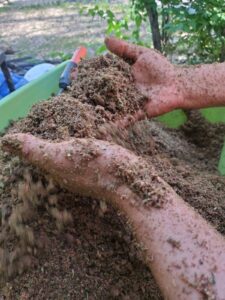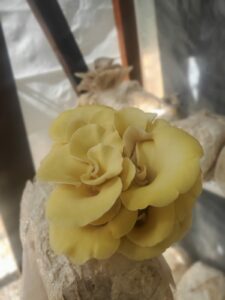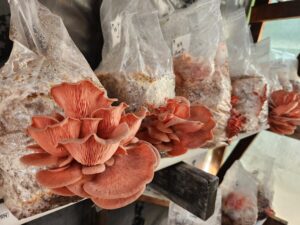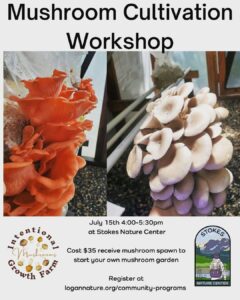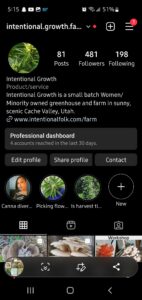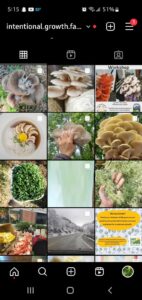Final report for FW22-400
Project Information
The main goals of this project were to study the economic, nutritional, and environmental benefits of using industrial hemp stalks as the nutrient source in standard mushroom media formulation.
Hemp stalks are a ubiquitous waste product following the reintroduction of industrial hemp as a valid agricultural commodity in the 2018 US Farm Bill. Specialty (edible) mushrooms are a separate commodity growing in popularity and economic value.
The project objectives were:
• Objectives 1 and 4: Compare the cost analysis to yield potential of oyster mushrooms grown on hemp stalks to that of the commonly used straw material as the nutrient source in standard mushroom substrate formulation.
• Objective 2: Compare differences in the nutrient value of mushrooms grown with hemp stalks vs. straw.
• Objective 3: Assess contamination rates of competing fungi (mold) in mushrooms grown on hemp stalks to that of straw.
We suspected that hemp stalks will provide an economic alternative that increases oyster mushroom yields and nutrition at a lower production cost. Additionally, hemp farmers will benefit from an increase in income potential from a currently labeled waste product.
Research results were disseminated via websites, workshops, community events, and social media.
The project's research objectives were:
- Compare the cost analysis to yield potential of oyster mushrooms grown on hemp stalks to that of the commonly used straw material as the nitrogen source in standard mushroom substrate formulation.
- Compare differences in the nutrient value of mushrooms grown with hemp stalks vs. straw.
- Assess contamination rates of competing fungi (mold) in mushrooms grown on hemp stalks to that of straw.
The Educational Objectives of this project were:
- Provide training and education at six on-farm tours (spring and fall 2023) for a minimum of 24 participants
- Provide research results at one community presentation (i.e. Q&A sessions), engaging over 40 participants
- Engage 2,000 new followers on two social media platforms by Dec 2023
- Present results from this study at two conferences, engaging with 80 participants
- Produce a technical paper or short video report with the results of this study
The first planting period (P1) was planned to begin mid-April. Project funding became available in June 2022, thus delaying the purchase of required equipment and the P1 start date. P1 planting occurred on 8/9/2022. Mushroom fruiting masses were measured in September and October. Mushroom sub-samples from this planting were sent to USUAL for analysis and the results are reported here. The second planting period (P2) continued in May and June 2023 (see 2023 updated wsare timeline).
At the same time, hemp stalk samples were sent to USU's Analytical Laboratory (USUAL) for total elemental analysis. This data is available in the project report. WSARE Hemp Elemental Analysis
Upon completion of the planting periods, yield measurements, and laboratory results were analyzed and presented.
Farm tours were provided from June to Sep 2022, and continued in the summer of 2023. Assimilation of results occurred continuously as data was acquired. The team presented data at community and extension events. An instagram page went live in Feb 2023.
Cooperators
- - Producer (Educator and Researcher)
- - Producer (Educator and Researcher)
- - Technical Advisor (Educator and Researcher)
Research
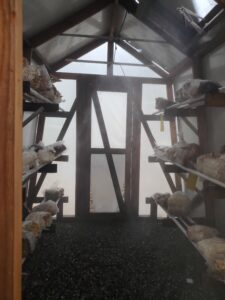
Small farming operations provide high levels of environmental stewardship and improve quality of life. They increase crop variety while steadily improving soil and water resources. Unfortunately, small farms are struggling and must find innovative means to maintain and improve profitability. Small industrial hemp farmers (under 10 acres) face a varied set of obstacles in a fast-growing, controversial, volatile market; and specialty mushroom farmers are entering a growth phase in mushroom popularity and economic growth potential. Together, these industries could symbiotically work together to capitalize on the unutilized hemp stalk supply and mushroom media demand.
The potential for recycling organic waste via fungi growth is essentially unlimited. Many commercial mushroom farmers choose sawdust and wood debris as primary substrate components. Mushroom growth habitat is additionally affected by structural composition, pH, and moisture. Intentional Growth Farm, LLC has dedicated an 8x10-foot greenhouse specifically built for the vertical placement of mushroom bags in a temperature and humidity-stable environment (figure 1).
Mushroom production consists of 3 primary stages: 1) propagation of mushroom culture; 2) inoculation of a grain media and incubation, and 3) launching the mycelium in grain media into a bulk substrate for fruiting. This project bypassed step 1 by using liquid mushroom cultures. Successful growing of mushrooms in stages 2 and 3 greatly depends on uncontaminated environments to eliminate competition from other undesirable fungi and bacteria, which directly impacts growth of the mushroom fruit body. Contamination vectors include the cultivator (the farmer), air, media, tools, inoculum, and mobile contamination units (i.e., insects and mites). The number of contaminants and the exposure time directly impact the severity of the contamination. Incubation of mushroom media and launching of grain into the substrate are especially susceptible to contamination. Complete media sterilization filtered air-flow hood, and cultivator sanitation are the most effective methods of reducing contamination rates.
Our research study inoculated rye-grain media with a liquid culture and incubated for 2 weeks. This permitted the mycelium to expand vigorously. Rye and grain media jars were sterilized in a 10-gal All American pressure cooker. After 2 weeks of incubation, the grain media was launched into a 1.5 lb bag of substrate and allowed to incubate for an additional 2 weeks. These large bags and the substrate in them also required pasteurization to kill off temperature-sensitive microorganisms. Pasteurization in the 10-gal pressure cookers has proven to be inconsistent. After incubation, the bags were strategically cut to allow gas flow exchange and the required humidity for the expanding mycelium to pin and fruit.
Research Design:
This research project measured yield, nutrient levels, and contamination rates of 3 species of oyster mushrooms: blue oyster, pink oyster, and king oyster. A randomized block design with the 3 species and 2 substrate nutrient sources (hemp stalks vs. straw) was used, repeating 2 times within the 2022 and 2023 seasons (table 1). Each treatment consisted of 9-1.5 lb bags (54 bags total) of substrate, all of which was pasteurized simultaneously in an 85-gallon mushroom substrate steamer to ensure complete, uniform pasteurization, and then inoculated with grain spawn. Oyster mushrooms typically fruit 3 to 5 weeks after inoculation of the substrate, at which point yield measurements and sub-samples for nutrient analysis were taken.
The study was repeated twice. Grain media jars were inoculated in 2022 (period 1), and 2023 (period 2) to provide repetition and statistical accountability.
Methodology:
Nutrient levels - Samples of straw and hemp stalks were analyzed for total elemental composition by the USU Analytical Laboratory (www.usual.usu.edu) in June, alongside the 2022 growing season. This analysis provided baseline data for nutrient levels of the two substrates and will be compared to data published in mushroom literature (such as Stamets, 2000).
Composite mushroom samples of each treatment were taken after harvest for elemental tissue analysis. Composite samples consisted of 3 randomly chosen sub-samples from each treatment type, resulting in 6 composite samples {{ a) blue/hemp; b) blue/straw; c) pink/hemp; d) pink/straw; e) king/hemp; f) king/straw}} for each of the grow-periods. The resulting samples assessed nutrient levels in each treatment type.
Yield - Yield will be measured and analyzed for differences in value among the treatments. Each measurement consisted of weighing the individual bags and the corresponding mass of harvested mushroom growth.
Contamination - contamination is the growth of unwanted fungi/mold, bacteria, and insects. Contamination reduces yield and profit. Contamination levels were reported throughout the study as a concentration. Jars or bags with contamination levels above 25% were discarded to prevent contamination of the other bags and were cited as a complete loss.
Economic Potential - Based on preliminary research conducted at IGF, we expected that the utilization of hemp stalks could be used to increase mushroom yield at a lower input cost than straw. The cost of materials including chipped hemp stalks, their regional availability, nutrient content, and performance (nutrient levels, yield, and contamination rate) in the mushroom substrate was calculated and compared to the cost and performance of sawdust.
The following are the results from P1 (2022) and P2 (2023) plantings:
This WSARE project began in 2022 and was completed in 2023. Funding availability delayed the start of our project from April to June 2022. At this time, we ordered the required equipment; 85 gal substrate streamer drum and a laminar flow hood, which were required for uniform pasteurization of all bags, tools, and equipment, and a sterile environment during incubation. Due to the shift in timeline, we were able to complete one planting (P1) in 2022. A second planting was begun on 9/12/2022, but the cold weather prevented the mushroom from fruiting. Therefore, only data from P1 were available for the preliminary analysis. The second and third plantings were scheduled to be accomplished in May and June 2023. Weather delays due to unseasonably high snowfall and low temperatures throughout April and May also prevented the project from starting on time in 2023. Therefore, the P2 planting began in June 2023. The results from P1 and P2 are provided here.
Objective 1 results - yield. In all plantings, hemp stalk was successfully used as a substrate to grow gourmet edible oyster mushrooms. Results from the first plantings show that hemp produced higher yields of blue and pink oyster mushrooms. Yellow oyster mushrooms produced greater yields with straw substrate. Results from the second planting continue to show that hemp produced higher yields of blue and yellow mushrooms.
No data for pink oyster mushrooms is available for 2023. The research team concluded that this was due to receiving yellow oyster liquid culture instead of the purchased pink oyster.
Objective 2 results- nutrient levels comparison of straw vs. hemp substrate. Straw has been extensively tested and reported (Stamets 2000). This project analyzed hemp stalks to assess their potential for substrate use (see table WSARE Hemp Elemental Analysis). The fruiting mushrooms grown on straw vs. hemp were also analyzed for nutrients (see pdf USUAL P1 and P2 elemental analysis). No significant nutrient differences between straw-substrate and hemp-substrate mushrooms were found in P1 or P2.
mushroom harvest yields 2022 and 2023
Objective 3 results - contamination. Overall, more bags with straw substrate suffered from contamination than bags with hemp substrate. In P1, four (4) straw bags (vs. 1 hemp bag) were contaminated out of the 54 bags used in the study. In P2, two (2) straw bags and 2 hemp bags were contaminated out of the 54 bags.
Objective 4 results - economic potential. Hemp hurd (the waste byproduct of growing hemp for CBD) is available for sale online for approximately $0.66/lb. Straw (a byproduct of wheat or other grain) is also available but at $1.49/lb. The average price of hemp is less than the average price of straw and is therefore a more economical choice.
hemp $0.66/lb (F-H15: 1/2" Hemp Hurds (hemptraders.com))
straw $1.49/lb (Rhino Seed & Landscaping Supply 10LB All Purpose Straw Bale - Esbenshades)
Research Outcomes
The research results show that hemp hurd (chipped stalks) can be successfully used as an edible mushroom substrate.
The following are recommendations based on the 2022 and 2023 results:
Objective 1 - yield. Hemp stalks (hurd) can successfully be used as the substrate to grow gourmet edible oyster mushrooms, resulting in higher yields than straw.
Objective 2 - nutrient levels. There were no significant differences between mushroom varieties grown with straw vs. hemp substrate.
Objective 3 - contamination. Mushroom bags that used hemp had overall lower amounts of contamination.
Objective 4 - economic potential. Hemp hurd is a waste product that is available for a lower cost than straw and oftentimes can be acquired for free from local hemp farmers who otherwise will simply dispose of it.
We recommend the use of hemp hurd as a material in the mushroom substrate for greater economic potential. The research shows that overall, the economic value of hemp for the mushroom substrate is greater, the yield higher, contamination slightly lower and nutrient levels are similar. The repurposing of a waste product (hemp hurd) to grow mushrooms promotes agricultural sustainability.
We recommend future research to study the use of hemp hurd as the substrate for less-hardy varieties of edible mushrooms such as lion's mane, shitake, and reishi. We also recommend replicating this experiment in a closed laboratory with more repetitions to lessen the variability that is inherent in a greenhouse/outdoor setting.
Education and Outreach
Participation Summary:
The Educational Objectives of this project are:
- Provide training and education at six on-farm tours (spring and fall 2023) for a minimum of 24 participants
- Provide research results at one community presentation, engaging over 40 participants
- Engage 2,000 new followers on two social media platforms by Dec 2023
- Present results from this study at a national/regional conferences, engaging with 80 participants
- Produce a technical paper and short video report with the results of this study
Three farm tours were executed from May to September 2022, with a total of 8 participants (5 adults and 3 children). Three additional tours took place from May to September 2023, with a total of 22 participants (20 adults and 2 children).
The delayed start of the project in 2022 and the unseasonable cold spring in 2023 did not hinder the completion of this project. Our farm tours showed us that involving the participant in the preparation of bags and harvesting of mushrooms increased enthusiasm and their desire to learn. In 2023 farm tours included a short educational component followed by participation in the construction of substrate bags, inoculation of mushroom mycelium into the bags under sterile conditions (utilizing the flow hood) and harvesting of fruited mushrooms.
This project was featured as a WSARE news story on January 12, 2023, "Farmers Test Benefits of Using Hemp Stalks to Produce Mushrooms." Six (6) people contacted us as a result of this article, and we have provided growing guidance on an ongoing basis to two (2).
Farmers Test Benefits of Using Hemp Stalks to Produce Mushrooms - SARE Western
Presentations at community events took place from June to September 2023. A community education class was given at the Stoke's Nature Center (12 adults participated in the class).
An Educational Infographic was provided to interested participants at the Cache Valley Gardener's Market (over 80 adults received flyers regarding mushroom growth; 10 participants acquired spawn bags to inoculate their garden). Eight (8) people responded with photos from their new garden patch.
Presentation of social media began in earnest in April 2023 t. The social media posted highlights of the project's outcomes, educational opportunities, and possibilities for increased mushroom growth. We are on our way to our target of 2,000 followers (481 followers as of September 2023).
A you-tube video by PostEgo (Jake), a local community advocate of all things interesting, interviewed Natasha Quinones at Intentional Growth Farm and showcased the mushroom production and research project. It currently has 31 views.
you-tube video https://www.youtube.com/watch?v=RRQyTzbtVdQ
Education and Outreach Outcomes
Our team has effectively disseminated these research results and will continue to work towards providing online information and simple educational materials such as an Infographic presented at local gardener's markets; social media interaction; community educational classes; and local tours.
The results of this project have helped other agricultural farmers/ranchers, urban farmers, and the general public realize the potential of using one ag waste product (hemp stalks) to support another (edible mushroom growth). Our outreach model has been effective, and our team will continue to make educational materials (USU Extension fact sheet) and participate with Bridgerland's Mushroom Society, Southern Idaho's Mycological Association, and the Utah Fungi Festival (May 13) in 2024 to showcase these results.
Since edible mushrooms do not require large tracks of land they can be grown in dense urban communities. Our team will also continue outreach by presenting these findings in 2024 at Salt Lake City's Mobile Moon Coop, a collective that aids communities & ecosystems through education, empowerment, and botanical stewardship. Flyers for the event, in English and Spanish, will be posted in international food shops, food co-ops, and other inner-city locations.
Ability to grow mushrooms on an agricultural waste product.
Ability to grow edible mushrooms on an outdoor patch using simple/repurposed agricultural waste products.
